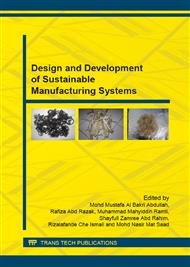[1]
D. Zhao, Q. Tian, M. Wang and Y. Jin: Journal of Bionic Engineering Vol. 11 (2014), p.296.
Google Scholar
[2]
L. Vedaprakash, R. Dineshram, K. Ratnam, K. Lakshmi, K. Jayaraj, S. Mahesh Babu, R. Venkatesan and A. Shanmugam: Colloids and Surfaces B: Biointerfaces Vol. 106 (2013), p.1.
DOI: 10.1016/j.colsurfb.2013.01.007
Google Scholar
[3]
A.M.A. Mohamed, A.M. Abdullah and N.A. Younan: submitted to Arabian Journal of Chemistry (2014).
Google Scholar
[4]
L. Yao and J. He: Progress in Materials Science Vol. 61 (2014), p.94.
Google Scholar
[5]
A. Nagaoka, K. i. Yokoyama and J. i. Sakai: Corrosion Science Vol. 52 (2010), p.1130.
Google Scholar
[6]
W. Grzesik, K. Żak and P. Kiszka: Procedia CIRP Vol. 13 (2014), p.84.
Google Scholar
[7]
U. Pettersson and S. Jacobson: Tribology International Vol. 36 (2003), p.857.
Google Scholar
[8]
D. Braun, C. Greiner, J. Schneider and P. Gumbsch: Tribology International Vol. 77 (2014), p.142.
Google Scholar
[9]
N. Valipour M, F.C. Birjandi and J. Sargolzaei: Colloids and Surfaces A: Physicochemical and Engineering Aspects Vol. 448 (2014), p.93.
DOI: 10.1016/j.colsurfa.2014.02.016
Google Scholar
[10]
H. -J. Butt, I.V. Roisman, M. Brinkmann, P. Papadopoulos, D. Vollmer, C. Semprebon: Current Opinion in Colloid & Interface Science Vol. 19 (2014), p.343.
DOI: 10.1016/j.cocis.2014.04.009
Google Scholar
[11]
E. Bormashenko: submitted to Advances in Colloid and Interface Science (2014).
Google Scholar
[12]
A.G. Demir, P. Maressa and B. Previtali: Physics Procedia Vol. 41 (2013), p.759.
Google Scholar
[13]
B.S. Yilbas: Ceramics International Vol. 40 (2014), p.16159.
Google Scholar
[14]
C. Ma, S. Bai, X. Peng and Y. Meng: Applied Surface Science Vol. 266 (2013), 51.
Google Scholar
[15]
B.S. Yilbas, M. Khaled, N. Abu-Dheir, N. Aqeeli and S.Z. Furquan: Applied Surface Science Vol. 286 (2013), p.161.
DOI: 10.1016/j.apsusc.2013.09.040
Google Scholar
[16]
M.R.H. Knowles, G. Rutterford, D. Karnakis and A. Ferguson: The International Journal of Advanced Manufacturing Technology Vol. 33 (2007), p.95.
Google Scholar
[17]
Z. Wang, Y. Su, Q. Li, Y. Liu, Z. She, F. Chen, L. Li, X. Zhang and P. Zhang: Materials Characterization Vol. 99 (2015), p.200.
Google Scholar
[18]
L. -K. Wu, X. -F. Zhang and J. -M. Hu: Corrosion Science Vol. 85 (2014), p.482.
Google Scholar
[19]
Y. Yin, T. Liu, S. Chen, T. Liu and S. Cheng: Applied Surface Science Vol. 255 (2008), p.2978.
Google Scholar
[20]
R. Qiu, D. Zhang and P. Wang: Corrosion Science Vol. 66 (2013), p.350.
Google Scholar


